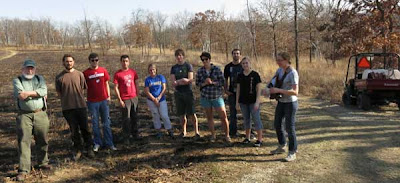Another big (final?) burn day
Yesterday, we burned 12 savanna units (30 acres), two prairies (Ridge and East Basin), and three oak woodland areas (Units 13, 20, and 21). We then finished off the day by doing the 2012 prairie burn at Black Earth Rettenmund. A long day. (We got home well after dark!)
We had a great crew (11 people), all very experienced burners who were all familiar with the habitats and terrain at the two sites. These are both high quality State Natural Areas and well worth careful attention.
The oak savannas we burned at PVC are what we call the "Ridge-top Savannas". These differ considerably from the South-slope Savannas that we burned on March 13, and the long-narrow savanna that we burned on March 15. Because these other two savannas had been burned, the Ridge-top Savannas were completely surrounded by blackline and hence we had no worries about containing the fire.
This burn season the fuel in our savannas is very lush, so there is no problem getting them to burn. However, lush fuel is conducive to very flashy burns, with high flame heights that are undesirable because they set high branches of the oaks on fire and do havoc to the snags. So for yesterday's burn, a backburn was used for the whole burn.
The area we burned is 0.6 mile long and has a complicated layout. (Because of the distances involved, we could not have done this burn without two-way radios.)
To accomplish the backburn while keeping the burning time within reason, we used the strip headfire technique. Four drip torches operated in parallel, about 100 feet apart. This ensured that any incipient headfire quickly ran into a parallel backfire and collapsed. Once started, the drip torches moved continuously until they reached the far end (where another crew had already established a black line).
 Four "waters" plus a pumper unit on a Kawasaki Mule took care of any problems that arose.
Four "waters" plus a pumper unit on a Kawasaki Mule took care of any problems that arose.Once the strips had been laid down, we could mostly wait for the backburn to reach the end of each unit. In a few areas, interior lighting was necessary, and to speed up the final process a narrow headfire was laid down at the bottom to complete the burn.
After a brief lunch, we did the rest of the burns at Pleasant Valley Conservancy and then moved to Black Earth Rettenmund Prairie for a late afternoon burn.
 An oddity. Halfway through our big savanna burn I heard a voice on my two-way radio calling Ken. We had no one on our burn crew with that name, but there is a Ken who manages another Prairie Enthusiasts (TPE) site (Pleasure Valley Conservancy; note the name difference) about 5 highway miles away. Obviously another TPE burn was in progress, operating on the same frequency we were.
An oddity. Halfway through our big savanna burn I heard a voice on my two-way radio calling Ken. We had no one on our burn crew with that name, but there is a Ken who manages another Prairie Enthusiasts (TPE) site (Pleasure Valley Conservancy; note the name difference) about 5 highway miles away. Obviously another TPE burn was in progress, operating on the same frequency we were.The weather yesterday was great for burns. According to Scott, the DNR forest ranger who stopped by at our burn, there were 35 burns going on in his district! It's encouraging to know that so much prescribed burn activity is going on in southern Wisconsin.





















